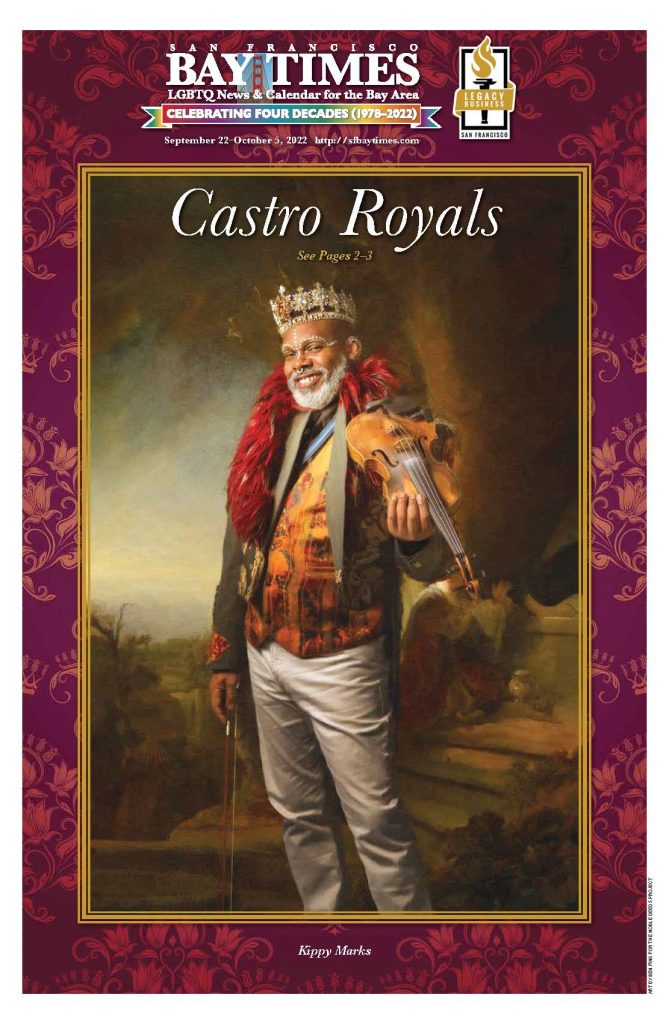
As a child, he was paraded through town in carriages and sedan chairs carried by dutiful followers. As an adult, he was welcomed by dukes, duchesses, czarinas, and assorted Court dignitaries who became silent and reverential in his presence, deferring to his leadership. His biography proudly begins with two family trees that display his lineage in two separate lines.
Who was this royal personage? He was legendary Bay Area-based drag artist José Julio Sarria (1922–2013), Absolute Empress I de San Francisco and founder of the Imperial Court System.
In his biography The Empress Is a Man by Michael Gorman (1998, The Haworth Press, Inc.), Sarria recounted the initial Empress moment. The setting was the glamorous and fantastical Beaux Arts Ball in San Francisco on Halloween, 1962:
“That night they declared me ‘Queen of the Ball,’ but they couldn’t make me queen; I was always the queen. So, I declared myself Empress José the First.”
LGBTQ Ties to Royalty
As significant and influential as Sarria was, the origin of his and the LGBTQ community’s ties to royalty date to long before 1962. There were, of course, many queer individuals—whether openly so or closeted—who were members of royal families since likely the beginning of monarchies and primogeniture. One could argue that the institutions themselves, not to mention those underlying many world religions, were shaped in large part by LGBTQ people and culture.
Some historical accounts hold that, starting from around the 17th century, men playing women’s roles in theatrical productions such as Shakespeare’s plays were said to “drag” their costumes on the ground, often while playing queens and other royal characters. The first recorded use of drag, though, dates to 1870 and is linked to balls like the one Sarria attended.
William Dorsey Swann
The first known person to self-identify as a “queen of drag” was the remarkable William Dorsey Swann (1858–1925). Born into slavery in Maryland, Swann after the Civil War organized a series of balls in Washington, D.C. It was at these events that he referred to himself as a drag queen. His social group consisted of other former slaves and fellow “rebel drag queens” and was known as the House of Swann. They often wore beautiful, handcrafted silk or satin gowns.
As you might imagine, Swann was arrested in police raids numerous times, including in the first documented case of arrests for female impersonation in the United States, on April 12, 1888. This event was Swann’s thirtieth birthday celebration, and according to The Washington Post, he was “arrayed in a gorgeous dress of cream-colored satin.”
After the birthday celebration was raided by police, Swann was “bursting with rage” as he stood up to one of the arresting officers and declared that the individual was not a “gentleman.” Swann’s choice to resist that night “rather than to submit passively to his arrest, marks one of the earliest-known instances of violent resistance in the name of gay rights,” according to a report by the Oxford African American Studies Center.
Castro Royals
The intertwined terminology, ceremonies, pomp, pageantry, and more that today link certain aspects of LGBTQ culture with monarchies going back hundreds of years therefore rest on the shoulders of brave and brazen individuals like Sarria and Swann. While the parallels with ancient royal institutions are unmistakable, San Francisco has evolved its own unique Court cultures—Imperial, Ducal, that of the GLBTQ+ Asian Pacific Alliance (GAPA), and still others. Even beyond these established groups, individuals have expressed their own creativity and identity through royal imagery.
Musician Kippy Marks, featured on the latest cover of the San Francisco Bay Times, is one such Castro royal. When he dons a crown and robe and plays his treasured violin Izabella, Marks can captivate audiences and earn followers. He is the king of the stage in such moments.
Artist Ben Fink noticed these qualities in Marks and others. He created the Bay Times cover image, and is in the process of compiling a series called Noble Deeds. The images, as for the one of Marks, draw from past fine art archetypes but bring them vividly into the present with modern LGBTQ portraiture. We hope the artworks will go on exhibit in San Francisco before long, since they are best experienced in person. For now, you can view them at https://tinyurl.com/y3nvj659

Live That Fantasy
San Francisco’s royal-imbued LGBTQ culture is accessible to all regardless of family lineage, wealth, and some of the other trappings of most established monarchies. This practice of putting royalty within reach goes back thousands of years. Even religious historians sometimes refer to Jesus as “the homeless king.” Matthew 8:20 in the Bible wrote: “Foxes have dens and birds have nests, but the Son of Man has no place to lay his head.” Rabbinic literature similarly uplifts the poor to royal-like stature, pointing out that they too are “sons of Abraham, Isaac, and Jacob,” suggests scholars from Bar Ilan University and the Ashkelon Academic College.
While, as pop star Lorde sings, most of us will never be actual royals, many of us still crave that kind of “buzz.” Whether you are already a Castro royal or one in the making, it is not too late to explore this side of yourself if you want to do so. Like Sarria, Ella Marija Lani Yelich-O’Connor envisioned a more regal life for herself. She changed her professional name to Lorde, rose to stardom, and, like Sarria before her, has dedicated many of her efforts to philanthropy. She will sing us out:
“Let me be your ruler (ruler)
You can call me queen bee
And baby, I’ll rule (I’ll rule, I’ll rule, I’ll rule)
Let me live that fantasy.”
Cover Story
Published on September 22, 2022
Recent Comments